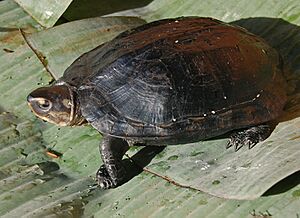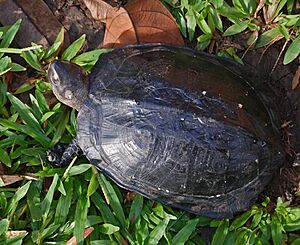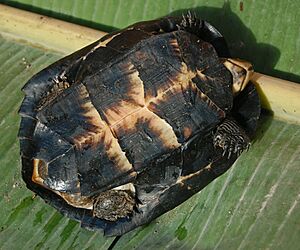Black marsh turtle facts for kids
Quick facts for kids Black marsh turtle |
|
|---|---|
 |
|
| A black marsh turtle warming up in the sun. | |
| Conservation status | |
| Scientific classification | |
| Genus: |
Siebenrockiella
|
| Species: |
crassicollis
|
 |
|
| Where the black marsh turtle lives. | |
| Synonyms | |
|
Genus synonymy
Bellia Gray 1869
Species synonymy
Emys crassicollis Gray, 1831
Emys crassicolis Duméril & Bibron, 1835 (ex errore) Clemmys (Clemmys) crassicollis Fitzinger, 1835 Bellia crassicollis Gray, 1869 Bellia crassilabris Theobald, 1876 (ex errore) Pangshura cochinchinensis Tirant, 1885 Kachuga cochinchinensis Mocquard, 1907 Orlitia crassicollis Barbour, 1912 Siebenrockiella crassicollis Lindholm, 1929 |
|
The Siebenrockiella crassicollis is a freshwater turtle often called the black marsh turtle. It's also known as the smiling terrapin or Siamese temple turtle. This turtle is special because it only lives in Southeast Asia. It belongs to a group of turtles called Siebenrockiella, which is part of the family Geoemydidae.
Black marsh turtles are small to medium-sized. They are almost completely black, but they have cool white or yellow marks on their heads. They love water and usually live in slow-moving or still places like ponds and swamps. These places often have lots of plants. People sometimes keep black marsh turtles as pets. They are also seen as special animals in Buddhist temples in Southeast Asia.
Sadly, the black marsh turtle is an endangered animal. This is because many turtles in Southeast Asia are caught and sold. They are often used for food or traditional medicine, especially in China.
Contents
What is a Black Marsh Turtle?
Black marsh turtles are now part of the Siebenrockiella group. A British zoologist named John Edward Gray first described them in 1831. For a long time, this group only had one type of turtle. But in 2005, scientists found that the Philippine forest turtle was actually very closely related. So, the Philippine forest turtle was also placed in the Siebenrockiella group.
Black marsh turtles are "cryptodires." This means they can pull their heads straight back into their shells. Other turtles, called pleurodirans, fold their necks sideways.
The scientific name "crassicollis" comes from Latin. Crassus means "thick" and collum means "neck." This describes their thick necks! The name of their group, Siebenrockiella, honors an Austrian zoologist named Friedrich Siebenrock.
People have many common names for these turtles. Some call them black terrapin, black mud turtle, or fat-headed turtle. In Indonesia, they are called kura-kura pipi-putih, which means "white-cheeked turtle."
Appearance and Features


Adult black marsh turtles are usually small to medium-sized. They are about 17 cm (6.7 in) long. Some can grow up to 20 cm (7.9 in), but it's rare to see them much bigger. Their top shell, called the carapace, is oval-shaped. It is widest in the middle and has a bumpy edge at the back. There's a clear ridge down the middle of the carapace. The carapace is usually black or dark brown with black patterns.
The bottom shell is called the plastron. It is flat and doesn't have a hinge. The plastron can be all black, dark brown, or yellowish with darker spots.
Their front legs have large scales. Both their front and back legs have webs between the toes. This helps them swim well. Their necks are thick, which is how they got their name. When they pull their head in, their neck forms a collar. Their legs, tail, and neck are dark gray to black. The head is wide with a short, pointed nose. It's mostly black on top, but it has cream or yellow marks around the eyes and on the throat. They also have two light spots behind their ears, which are often hidden. Their strong jaws are light yellow or brown and curve upwards. This makes them look like they are smiling, which is why they are called "smiling terrapins."
Male and female black marsh turtles look a bit different. This is called sexual dimorphism. Males have a slightly curved-in plastron, while females have a flat one. The yellow marks on the head, which all young turtles have, disappear in adult males but stay on females. Males also have longer and thicker tails than females.
Where They Live
Black marsh turtles live in southern Vietnam, Cambodia, southern Myanmar, and central and peninsular Thailand. They are also found in eastern and western Malaysia, Singapore, and the Indonesian islands of Java, Kalimantan, and Sumatra. Recently, one was found on Belitung Island. This shows they live in an even wider area than thought before.
These turtles live in warm water that moves slowly or is still. They like places with lots of plants, like marshes, swamps, and ponds. As their name suggests, they mostly live in water. They often bury themselves in soft mud when they are not looking for food.
Daily Life and Habits
Black marsh turtles mainly eat meat. They prefer to eat underwater. They hunt insects, worms, snails, frogs, crabs, and small fish. Sometimes, they will also eat rotting plants, fruits, or dead animals that fall into the water. Young turtles tend to eat more meat than adult turtles.
These turtles are shy. They are mostly active at night and spend most of their time in the water. They might come out onto land at night to find food or a mate. Sometimes, they come out during the day to warm up in the sun. Most of the time, they stay underwater, partly buried in mud in shallow areas, or swimming near the bottom in deeper, still waters.
If a black marsh turtle feels threatened, it can release a bad-smelling liquid from its body. This helps scare away animals that might try to eat it. Their strong jaws can also bite hard if someone handles them roughly.
Life Cycle
Black marsh turtles are ready to have babies when they are about five years old. They lay eggs in the summer, usually from April to the end of June. During courtship, the male turtle bobs his head and chases the female. He might even gently bite her legs before they mate. Females usually lay three or four groups of eggs. Each group has one, or sometimes two, large eggs. These eggs are about 5 by 3 cm (2.0 by 1.2 in) and weigh about 30 g (0.066 lb). The eggs hatch after about 68 to 84 days. The baby turtles are quite big when they hatch, about 5 cm (2.0 in) long.
In zoos, black marsh turtles have been known to live for about 60 years.
Turtles and People
Black marsh turtles are important in Buddhism. In Thailand, many black marsh turtles and yellow-headed temple turtles are released into temple ponds. Buddhist monks care for them there. People see these turtles as sacred. They believe the turtles hold the souls of people who died trying to save others from drowning. This is why one of their names is "Siamese temple turtle."
A study in 2010 found that black marsh turtles can have high levels of mercury in their bodies. Because of this, people are told not to eat them, as it could cause mercury poisoning.
Today, black marsh turtles are being raised in captivity. This helps with conservation efforts and also provides pets. In 2004, a black marsh turtle hatched at the Bristol Zoo Gardens in Europe. It was the first of its kind to hatch successfully in a European zoo. Turtles raised in captivity make better pets. They are healthier and more used to being handled than turtles caught from the wild.
Protecting Black Marsh Turtles
The International Union for Conservation of Nature says that black marsh turtles are an endangered species. They are also listed on CITES Appendix II. This means that trading them across borders is controlled to protect them. Besides CITES, Thailand also protects them under a special law. Other countries like Myanmar, Singapore, and Vietnam have general laws that protect freshwater turtles and wildlife, which also help black marsh turtles.
Despite these protections, the biggest danger to black marsh turtles is the huge demand for them in the international meat trade. This is especially true for Chinese food markets. Because of this, black marsh turtle numbers in Cambodia and Vietnam are already very low. Their bottom shells are also used in traditional Chinese medicine. Many thousands of these turtles are caught and sold illegally. This is a big problem because it means many wild turtles are disappearing. Also, the places where black marsh turtles live are being destroyed. This is called habitat loss.
See also
- Siebenrockiella leytensis, the Philippine forest turtle



